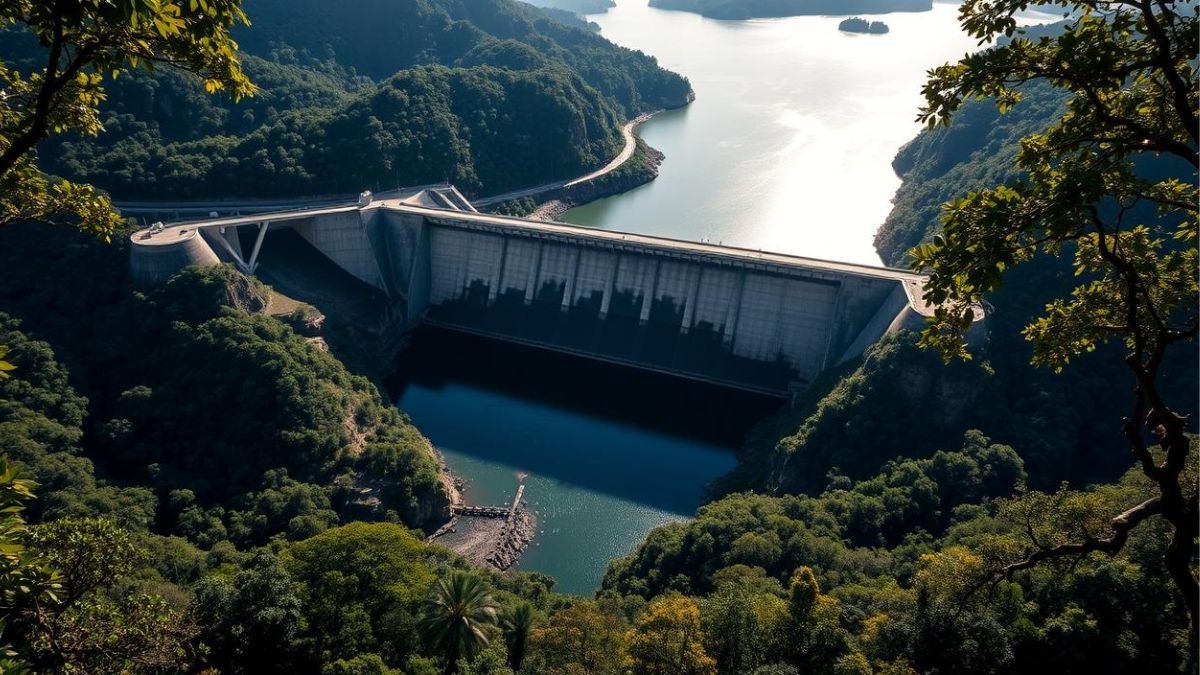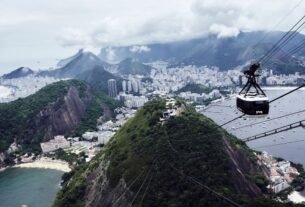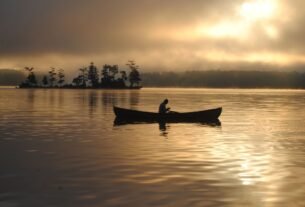Introduction
What if a single engineering marvel, the Tucuruí Brazil Dam, could power millions of homes, reshape an entire region, and hide untold stories beneath its concrete walls? The Tucuruí Dam, stretching 12.5 kilometers across the Tocantins River, does just that, and more.
This monumental structure generates a staggering amount of electricity and serves as a focal point for discussions about sustainability and the balance between progress and preservation.
Its sheer scale and complexity are a testament to human ingenuity, yet they also mask the intricate web of social and environmental challenges that have arisen in its wake. As one of the largest dams in the world, Tucuruí represents a pivotal moment in Brazil’s quest for energy independence, showcasing advanced engineering techniques and innovative design that have become benchmarks in the field.
However, this impressive feat of construction came at a significant cost, as it necessitated the flooding of vast areas of land, displacing entire communities and disrupting local ecosystems. The dam’s impact reverberates through the region, highlighting the often-overlooked consequences of such grand projects on both human lives and the environment.
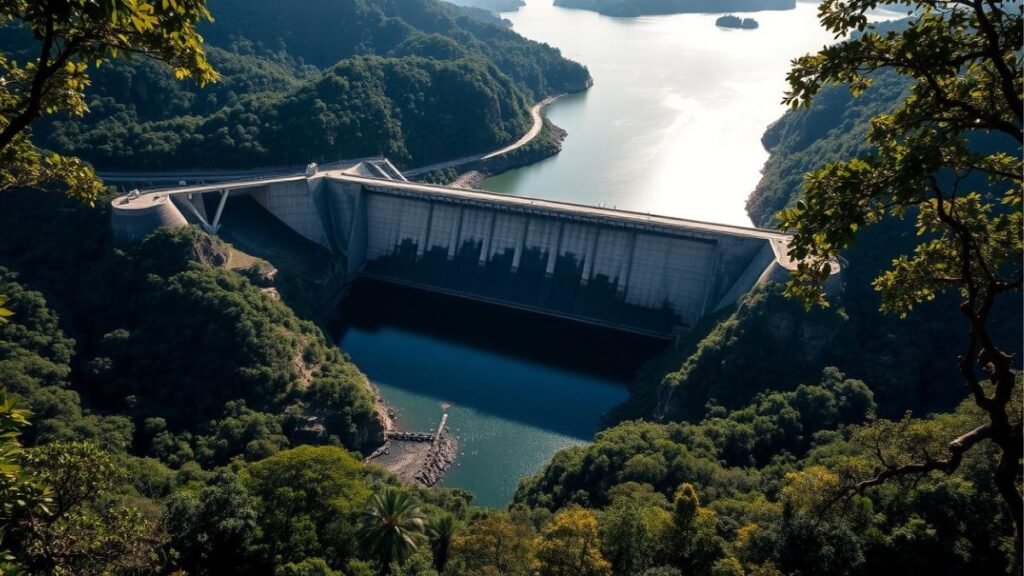
Built in the 1980s, this colossal project generates 8,370 megawatts of electricity, making it a cornerstone of Brazil’s energy development. But beyond its staggering size lies a tapestry of human drama, environmental paradoxes, and even Hollywood connections.
The dam’s construction altered the landscape significantly and impacted the lives of countless individuals, particularly indigenous populations who were displaced from their ancestral lands. These communities faced profound changes, as their traditional ways of life were disrupted, leading to social and cultural upheaval.
From indigenous displacement to its role in fueling an aluminum boom, the dam’s legacy is as complex as its engineering. The influx of energy facilitated the growth of industries that heavily relied on electricity, thereby transforming the regional economy.
However, this economic advancement came at a cost, raising questions about sustainability and environmental responsibility. Its Tupi name, meaning “river of ants,” hints at deeper layers waiting to be uncovered, as it symbolizes the natural habitat that was altered, the interconnectedness of life that was disrupted by this monumental project.
Key Takeaways
- The dam ranks as the world’s fourth-largest concrete gravity structure.
- It powers industries and homes with an 8,370 MW capacity.
- Construction sparked both economic growth and ecological debates.
- Indigenous communities were significantly impacted by its creation.
- Its location on the Tocantins River plays a key role in regional navigation.
1. The Ambitious Vision: How Tucuruí Brazil Became an Engineering Marvel
Turning a river into a powerhouse required more than concrete; it demanded vision, controversy, and relentless effort. The Tucuruí Dam originated from 1964 feasibility studies conducted by the U.S. Bureau of Reclamation, which aimed to tame the Tocantins River.
By 1975, construction began, but the project faced immediate hurdles, from funding gaps to environmental debates that questioned the long-term impacts on local ecosystems. Engineers and planners had to navigate complex logistical challenges, including the transportation of materials to remote sites and the need for innovative construction techniques to deal with the region’s unique geography.
The sheer scale of the project demanded physical resources and a robust framework for managing the diverse stakeholders involved, including government agencies, local communities, and environmental groups. As discussions intensified, it became clear that this ambitious undertaking was not just a technical feat but also a social experiment that would affect countless lives.
The balance between harnessing natural resources for energy and preserving the ecological integrity of the area became a focal point of contention, illustrating the broader struggle between development and environmental stewardship.
From Blueprint to Reality: The Dam’s Controversial Beginnings
Phase I flooded 2,850 km² of rainforest to install 12 turbines, each generating 350 MW. This massive inundation transformed the landscape, displaced indigenous communities and wildlife, leading to significant cultural and ecological disruptions.
The reservoir displaced indigenous communities and wildlife, sparking protests that highlighted the voices of those who were losing their ancestral lands. These protests were not merely local outcries; they resonated globally, drawing attention to the plight of marginalized groups and the urgent need for inclusive dialogue in large-scale projects.
Environmentalists raised alarms about the irreversible damage to biodiversity and the displacement of numerous species, igniting a fierce debate over the balance between progress and preservation. The loss of habitat for countless flora and fauna raised questions about the long-term sustainability of such developments.
Despite delays, the first phase wrapped in 1984, three years behind schedule, reflecting the tumultuous journey from concept to reality, marked by both technological triumphs and profound ethical dilemmas. The experience gained during this phase set the stage for future discussions about responsible development and the need for a more harmonious relationship between human progress and the environment.
Phase I vs. Phase II: A Tale of Delays and Overhaul
Modernization occurred during Phase II (1998–2010), which added 11 advanced turbines designed to enhance efficiency and reduce operational costs. These state-of-the-art turbines were engineered with cutting-edge technology, which improved the overall energy output and minimized the environmental footprint associated with their operation.
The upgrades increased capacity to 8,370 MW, significantly enhancing the dam’s output potential and enabling it to meet the region’s growing energy demands. However, despite these advancements, navigation locks remained unfinished, which limited river transport and hindered the movement of goods and resources along the region’s vital waterways.
This incomplete infrastructure posed challenges for local economies that relied on river transport for trade and commerce, creating bottlenecks that hindered the flow of essential supplies and agricultural products. As a result, local businesses faced increased operational costs and delays, which ultimately stunted economic growth and development in the surrounding areas.
| Aspect | Phase I (1975–1984) | Phase II (1998–2010) |
|---|---|---|
| Turbines | 12 x 350 MW | 11 x 375 MW |
| Cost | $5.5B (85% local funding) | Undisclosed |
| Challenges | Rainforest flooding | Infrastructure gaps |
Powering Industries: The Dam’s Role in Brazil’s Aluminum Boom
Today, 60% of the dam’s output fuels smelters, such as Companhia Vale do Rio Doce, which are critical to Brazil’s burgeoning aluminum industry. Eletrobras reports 21.4 TWh annual generation, enough to power approximately 13 million people. Yet, the paradox persists: clean power versus ecological loss, as the environmental consequences of such large-scale energy production continue to raise concerns among conservationists and local communities alike.
For 20,000 workers, construction created boomtowns that provided jobs and economic opportunities in an otherwise underdeveloped region. Now, the dam stands as both a symbol of development and a reminder of trade-offs, highlighting the complex relationship between energy needs and environmental stewardship.
2. The Hidden Costs: Environmental and Social Impacts of the Tucuruí Dam
Behind the massive concrete walls of the dam lies a story of sacrifice. While it powers industries and cities, the project left deep scars on both people and nature.
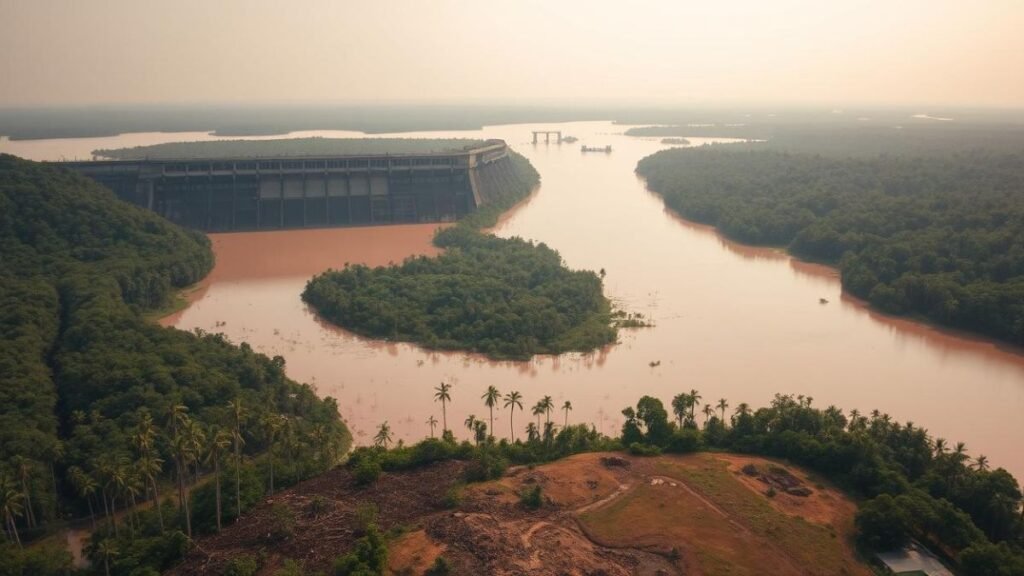
Displacement and Discontent: The Human Toll of Progress
Over 32,000 people were forced to leave their homes in the 1980s, as the construction of the dam necessitated the flooding of vast areas. Only 14,000 received government relocation assistance, which often fell short of meeting their needs. The rest, including 3,750 families, were sent to underdeveloped islands with poor infrastructure, lacking essential services such as clean water and adequate healthcare. Many of these families faced significant challenges in rebuilding their lives in unfamiliar territories, as they grappled with the loss of their cultural heritage and community ties.
Indigenous tribes, such as the Parakanã and Asurini, lost 60% of their fishing grounds, which were vital for their sustenance and cultural practices. Many still struggle to adapt decades later, facing ongoing challenges related to food security and access to traditional fishing practices. The disruption of their way of life has led to a loss of identity and cultural erosion, as they are forced to navigate a world that no longer accommodates their ancestral practices.
- Health crises emerged post-construction, exacerbated by the displacement and poor living conditions.
- Malaria cases rose by 25%, overwhelming local health services that were already strained.
- AIDS spread among migrant workers, who often lived in close quarters and faced inadequate healthcare access, compounding the public health crisis in the region.
Flooded Forests: How the Dam Altered the Amazon Ecosystem
The reservoir drowned 2,850 km² of rainforest, submerging vast areas of rich biodiversity that had thrived for centuries. This significant loss of habitat resulted in a decline in fish populations, reducing the number of species from 280 to just 178, and drastically reducing the ecological diversity that once characterized the region. Amazon river dolphins, which rely on healthy aquatic ecosystems for survival, now face extinction in the area, highlighting the severe impact on these iconic creatures and the delicate balance of life in the river.
“900 out of 1,500 tons of fish biomass were destroyed,” according to a World Commission on Dams study, illustrating the magnitude of the ecological disaster that unfolded. The loss of fish species affects the food web disrupts the livelihoods of local communities that depend on fishing for sustenance and economic stability.
Nutrient overload created ideal breeding sites for mosquitoes. This led to increased disease risks for nearby communities.
Rising Waters, Rising Protests: The Fight for Indigenous Rights
Activists like Dilma Ferreira Silva, assassinated in 2019, led the charge against the dam’s impacts, becoming symbols of resistance for their communities. Their efforts were not just about opposing the dam but also about advocating for the rights of Indigenous peoples and the preservation of their ancestral lands. The Movement of Dam-Affected Peoples staged bold protests, rallying thousands to raise awareness of the environmental and social injustices caused by the dam’s construction.
In 2007, they occupied the Piratininga Ranch, a strategic move that drew national attention to their plight. This occupation highlighted the ongoing struggles for land rights and the adverse effects of displacement on local populations. Land conflicts near reservoir zones continue today due to illegal “grilagem” practices, where land is fraudulently claimed, further exacerbating tensions between Indigenous communities and encroaching settlers.
The river that once sustained life now divides communities, severing traditional ties and disrupting cultural practices. While the dam brought power, its true cost remains debated, as the environmental degradation and social upheaval challenge the notion of progress in the region.
3. Beyond Electricity: Unexpected Stories from the Tucuruí Dam
The dam’s legacy extends far beyond megawatts, into folklore, film, and food. While its turbines power cities, its cultural ripple effects are equally profound. From indigenous legends that speak of the river’s spirit to silver-screen fame that captures the struggles of local communities, the structure has woven itself into regional identity.
The stories told by the Indigenous peoples, passed down through generations, reflect a deep connection to the land that the dam has altered irrevocably. Furthermore, local culinary traditions have evolved, with dishes inspired by the region’s rich biodiversity now celebrated in festivals that pay homage to both the river and the dam.
This blend of history and modernity illustrates how the dam has transformed the landscape and reshaped the cultural fabric of the area, making it a pivotal part of local heritage.
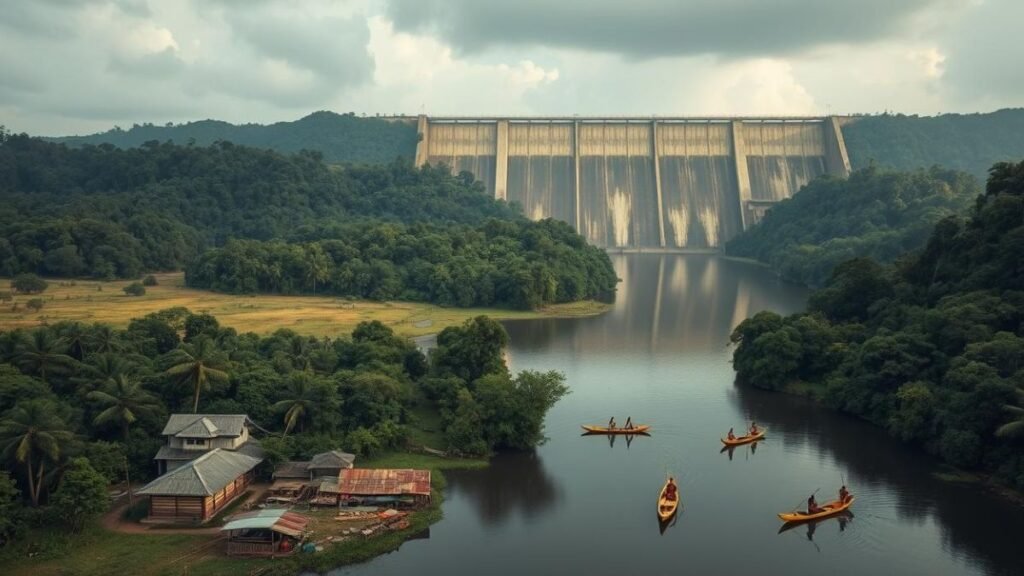
The “River of Ants”: Origins of the Indigenous Name
Local Tupi-Guarani tribes named the river “tukura’y,” meaning “ant/locust water.” This name is steeped in cultural significance, reflecting the tribes’ deep understanding of the ecosystem and the swarming fish migrations that were once a breathtaking spectacle during the dry seasons. The vibrant life that thrived in and around the river was not just a source of sustenance but also a vital part of their cultural identity and spiritual beliefs.
Today, the dam’s reservoir obscures this natural spectacle. Still, the name endures in museum content and oral histories, serving as a poignant reminder of the past and the enduring legacy of the Indigenous peoples who have called this land home for centuries.
Hollywood’s Spotlight: A Dam in The Emerald Forest
The 1985 film The Emerald Forest used the site as a backdrop, showcasing the stunning landscapes and the complex interplay between nature and human intervention. Director John Boorman framed it as both an engineering triumph and an ecological warning, illustrating the consequences of progress at the expense of indigenous cultures. Scenes showed displaced indigenous communities, mirroring real-life controversies surrounding the dam’s construction and its impact on local populations and their way of life.
The film highlighted the struggle for identity and survival amidst the encroachment of modernity, resonating with audiences worldwide.
“The dam became a character—its shadow looming over every conflict,” noted film critic Roger Ebert, emphasizing how the structure symbolized the broader themes of loss and resilience faced by the communities affected by such developments.
From Fish to Festivals: Reshaping Local Culture
The artificial lake birthed new traditions. The annual Tucunaré Festival celebrates the Cichla fish with dishes like peixe no saco (fish steamed in palm leaves). Meanwhile, the Eletronorte Cultural Center showcases working dam models, blending education with tourism options.
| Cultural Shift | Before Dam | After Dam |
|---|---|---|
| Fishing Economy | 280 native species | 178 species, new aquaculture |
| Festivals | Harvest rituals | Fish-focused events |
| Tourism | Limited access | Reservoir tours, airport nearby |
Even the extinct Brazil Nut Railway lives on in museum relics. Locomotives near spillways whisper of an era when the Tocantins River was a vital trade route, not a source of power.
Conclusion: Tucuruí’s Legacy, Progress at What Price?
The dam stands as a paradox, delivering clean power while leaving deep scars on the landscape. A 2022 PNAS study raises questions about the sustainability of hydroelectric projects like this compared to solar alternatives, underscoring the need for a critical evaluation of energy sources. The Tocantins River now fuels industries, yet local communities still grapple with unresolved displacement, struggling to adapt to the changes that have disrupted their traditional ways of life.
With 60% of its output powering aluminum plants but employing fewer than 2,000 locals, the project’s economic benefits remain uneven, raising concerns about the true cost of progress. Meanwhile, indigenous lawsuits highlight ongoing constitutional violations under Article 231, as many tribal members continue to fight for their rights and recognition amidst the sweeping changes brought by the dam.
Recent $1.35B upgrades contrast sharply with unfulfilled relocation promises, leaving many families in limbo. As research shows, tropical dams emit methane, yet offset fossil fuel use, complicating the environmental narrative surrounding such projects. The balance between progress and preservation remains fragile, with the ecological impacts of altered water flow and fish populations threatening the biodiversity that once thrived in the region.
The question lingers: Can future energy solutions honor both the land and its people? Learn more Santarém Brazil.
FAQ
What makes the Tucuruí Dam an engineering marvel?
The dam transformed the region by harnessing the power of the Tocantins River, becoming one of the largest hydroelectric projects in the world. Its construction faced delays but ultimately fueled Brazil’s industrial growth.
How did the dam impact local communities?
Thousands were displaced, and indigenous groups protested the flooding of ancestral lands. The reservoir altered livelihoods, sparking debates over development versus human rights.
Why is the dam called “Tucuruí”?
The name originates from an indigenous term meaning “River of Ants,” referring to the area’s history before the reservoir reshaped the landscape.
Did the dam appear in any famous films?
Yes, it was featured in the 1985 movie The Emerald Forest, highlighting its dramatic setting and environmental themes.
What industries benefited most from the dam’s power?
Aluminum production boomed due to cheap electricity, turning the region into a key industrial hub for Brazil.

